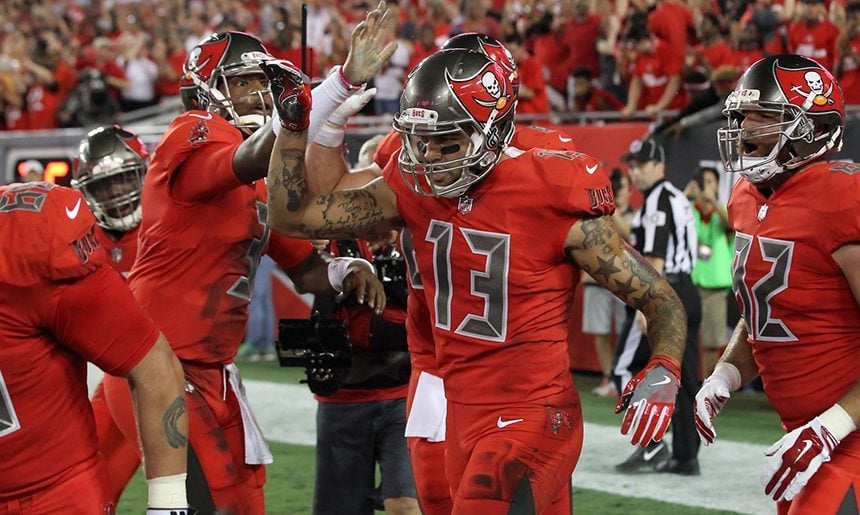Sikkema’s *Scheme of the Week Part III
Cover 2 (Tampa 2)
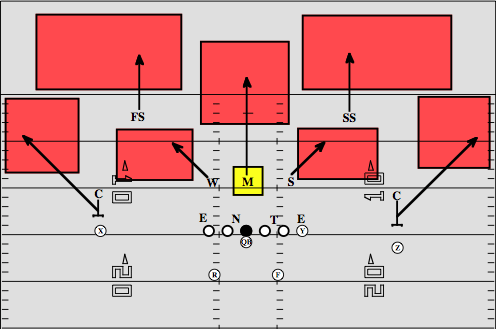
via NFPost
The Cover 2 defense is the one Tampa fans love to talk about because, well, a certain style of it was named after their team because they were so good at it.
In a Cover 2, anticipation is key. You have to have great communication with the rest of the defense, and the unit has to work as one to act as if there aren’t any holes, when, in reality, there are.
The set up is in the name. At it’s base, it consists of two deep coverage players in both of the safeties, while both of the cornerbacks play in shallow zones 0-10 yards off the line of scrimmage. Timing and technique are everything in this formation, because it’s up to the cornerbacks to hold or deceive the receivers and quarterback long enough for the pass rush to get where it needs to be before they realize where the hole in the zone is – because it is there.
There are three main holes in a Cover 2 defense: two seams up the sideline from about 5-15 yards off the line of scrimmage between where the cornerback’s zone ends and the safety’s zone begins, and also a zone behind the linebackers and between the safeties in the middle of the field as well.
This is where Tony Dungy, Monte Kiffin and the Tampa 2 came in. As the NFL began to evolve and we started to see more athletic players, like tight ends, catch passes in that middle seam, the Cover 2 was starting to fade away. But, in the last 1990’s, Dungy and Kiffin decided to take one of their athletic linebackers and drop him into a disguised coverage role in the middle of the field, almost as deep as a third safety. Bring in Hall of Famer, Derrick Brooks, and the rest is history. Quarterbacks were caught off guard for years until the game got even faster and the playing field of this strategy has evened out again.
But, even though the Tampa 2 isn’t what it used to be, it still has its moment as shown below from last season.
In a #WellActually moment, here's the Tampa 2 example I was looking for. INT Tandy. pic.twitter.com/n5dYS6sgDc
— Trevor Sikkema (@TampaBayTre) June 27, 2017
Cover 2 and the Tampa 2 still work on occasion for the Buccaneers because they have he personnel to do it. Their defensive backs are more smart than they are imposing, and they’re more anticipatory than they are naturally aggressive. Not to mention middle linebacker, Kwon Alexander, is one hell of an athlete, and has the speed to drop back into coverage well – he just need to be more consistent with it, which he has said he wants to do.
In Year 2 of Mike Smith’s defense, the communication will be better, and we may even see more Tampa 2 from them because of it. Having two safeties who know how to play both free and strong safety at any time also make the Cover 2 advantageous for this Buccaneer group.
However, all that in mind, our next shell is actually the one that’s been a great fit for the Buccaneers so far under Smith, and should continue to be their go-to moving forward.
Soft Cover 3
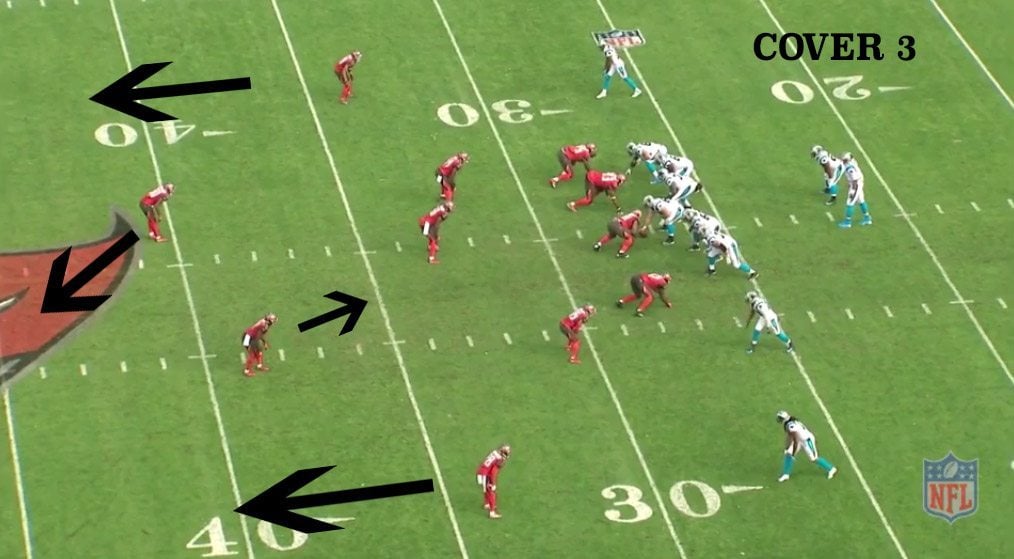
Bucs versus Panthers Week 17, 2016
There are a few different ways you can play a Cover 3. I’ll start with how the Bucs play theirs.
The basics of a Cover 3 are three players dividing the deep zone into thirds with zone coverage underneath at the second level – anytime an outside cornerback takes a deep zone, it will be the closet linebacker’s job to watch the flats in a shallow zone below them. In almost all cases, the three players who are manning the deep zone will be the two outside cornerbacks and the free safety.
In a “soft” Cover 3 look, the strong safety will hold his position on the back end in the pre-snap as to possibly fool the quarterback into thinking the defense may be in Cover 2, but his first step will be forward towards the line of scrimmage and into his second-level zone. In a soft Cover 3, the outside cornerbacks will be in “off man” coverage, not press, which means they’ll be giving plenty of space to the wide receivers. This limits the possibility of the cornerbacks being burned deep with only one player back to help. Contrary to what we think with modern successful Cover 3 (think Seattle and Denver), the Buccaneers play a much less agressive and more patient style of Cover 3.
Like the Cover 2, the soft Cover 3 is meant to be somewhat of a damage control setup – or, at least, that’s how the Buccaneers play it. In the screenshot above, you can see how it looked for them in the pre-snap. Tampa Bay plays in this formation a lot, and they do that for a few reasons. First, it’s because of the types of cornerbacks and safeties they have. Their cornerbacks are all under 6-foot, their free safeties can cover but aren’t all-world athletes, and their strong safeties can tackle but aren’t built to hit like linebackers. Therefore, they keep things fluid and open to help rather than in lockdown, specific roles.
The Buccaneers like their defensive backs to be smart, and have great anticipation and acceleration above all else. The full play of the screenshot above shows why.
#Bucs in Cover 3. Corners playing off, one safety deep. Great read by Grimes. This is why they play this shell the most. pic.twitter.com/QOIIRtDOZn
— Trevor Sikkema (@TampaBayTre) June 27, 2017
When we talk about a “Buccaneer corner” this is what we’re talking about. It’s about picking your battles. It’s about being patient, knowing you’re going to give up some catches, but doing your homework the week before, staying focused throughout the game, and pouncing when you see that play or route you studied in the week leading up.
Soft Cover 3 allows the Bucs to play to the style of players who are more suited for a Cover 2, but with less of the holes and seams given up by nature of the two-deep coverage shell.
Seattle Cover 3
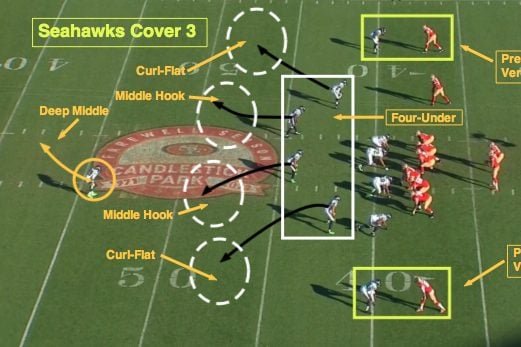
via Bleacher Report
There’s probably a more common term for this kind of Cover 3 (or maybe there isn’t), but I’m going to call it a “Seattle Cover 3” because that’s what everyone knows it as.
Just like the soft Cover 3 is a hybrid with Cover 2, the Seattle Cover 3 is a hybrid with Cover 1. In it, you have the same roles from each player in the secondary, those roles are just much more defined in a more aggressive nature with less room for error.
A Seattle Cover 3 must – and I mean must – have an all-world athlete, and all-world football player, honestly, at the free safety position. The engine that makes Seattle’s aggressive defense go is safety Earl Thomas. Without Thomas on the back end being able to cover the range he does, that defense doesn’t work. We saw how fast the wheels fell off Seattle’s defense late in the year when he was hurt. Next, there has to be at least one elite lockdown outside cornerback. That’s Richard Sherman. After that you want to have another corner who is comfortable playing a man-to-man style on one side of the field. Finally, you have to have a strong safety who hits, wraps up, has the size to at least take on lead blockers, and can chase like a linebacker. That’s Kam Chancellor.
An aggressive Cover 3 is all about buying time for a good pass rush. When you have the kind of aggressive players in the secondary that Seattle does, they’re able to lock down their receivers for three to four seconds on a regular basis, which is a long time for an offensive line to block a team like Seattle.
Seattle’s defensive series end in the extremes. There aren’t all these bend-but-don’t-break drives that are long and sustained that only end in three points. More than any other style of defense, Seattle’s Cover 3 either ends in a touchdown, a turnover or a limited drive that could be as short as a three-and-out.
The Buccaneers do not have the personnel to run this kind of defense. They don’t have a cornerback with length who can match up against a team’s No. 1 wide receiver on the outside consistently, they don’t have an all-world athlete at the free safety position, and they don’t have a thumping strong safety. Buccaneers and the Seahawks are two Cover 3 teams that look nothing alike in the secondary.
Cover 4
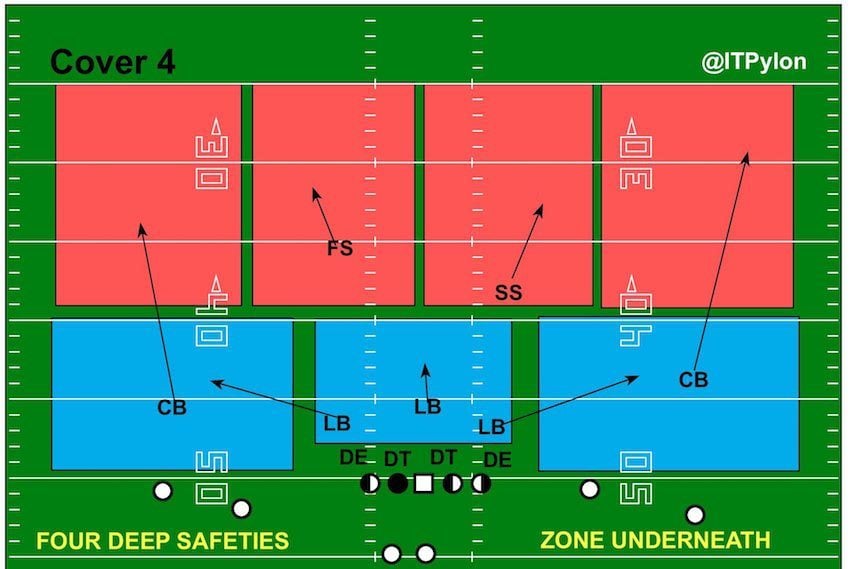
via Inside The Pylon
Cover 4 is essentially the prevent defense look teams like to use late in the game.
It comes from the Cover 2 family tree, but, in it, you just drop both of your cornerbacks to the deep zone as well. With four players in the deep zone, the odds of getting beat on a long pass should be very slim.
It doesn’t take a certain kind of defensive back to run a Cover 4, just one that isn’t undisciplined enough to let something get behind them.
Cover 6
Cover 6 is a hybrid coverage shell that is a bit deceiving because, at times, you could look at it and think it should be called a “Cover 7” depending on the down a distance and how many players actually drop back. But, what you need to know for a Cover 6 is that half the field plays like a Cover 4 and half the field plays like a Cover 2 (that’s why it’s called a Cover 6, not Cover 7).
The reason this kind of shell exists is because, more often than not, the ball is not going to be snapped right at the middle of the field. Instead, it’s going to be closer to either the right hash mark or the left.
Let’s say the ball is placed closer to the right hash mark. That means there’s less space for the offense to work with on that side. Less space or danger for the defense means they can get away with only having one safety to help on that side. Because of this, the cornerback on the boundary side of the field will play as if it’s a Cover 2 in a short zone, and one safety will be behind him. On the field side, with more space to cover, the field cornerback will retreat back as if he’s playing in a Cover 4 with the other safety next to him in a deep zone as well, and the linebacker or nickel corner will fill in the short zone on the field side.
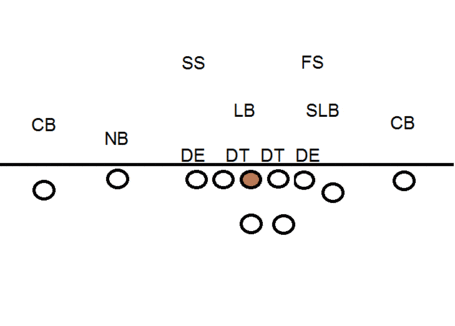
via Phinsider
This can also be called “cloud” coverage as we stated early on the terms page where the defense rotates.
So there you have it. Those are coverage shells in a nut shell. There are different ways that teams can disguise what they’re doing in nickel and dime defenses, but most of the time sub package players on the field will be in man coverage anyways, and the rest of the defense will still be able to run its own coverage shell.
Hopefully this helps you understand why the Buccaneers, not only perform the way they do, but also acquire the players they do in the secondary. The Bucs have the most success when they can keep things in front of them. They’re not about bullying receivers off the line or going stride-for-stride with them on every play attached at the hip. Instead, they’re looking to pick on the quarterback by bank on homework done the week before and communication done on game day to make things happen. It’s much more of a brains over braun approach.
This is also why players like Revis just didn’t fit in with what Tampa Bay was doing. Getting their hands on Revis was a good thought process, but the execution of his talent never fit with what the team was trying to do. Revis isn’t a off coverage zone player. He’s a man-to-man corner who wins by being way more athletic than almost every receiver in the league. He wasn’t being used properly in Tampa Bay, although his recovery from an ACL injury the year before limited his athleticism somewhat, and also in how the Bucs were able to use him. His reputation earned him the Pro Bowl more so than his stats.
Hopefully now you know what works, what doesn’t and why.
Trevor Sikkema is the Tampa Bay Buccaneers beat reporter and NFL Draft analyst for PewterReport.com. Sikkema, an alumnus of the University of Florida, has covered both college and professional football for much of his career. As a native of the Sunshine State, when he's not buried in social media, Sikkema can be found out and active, attempting to be the best athlete he never was. Sikkema can be reached at: [email protected]

